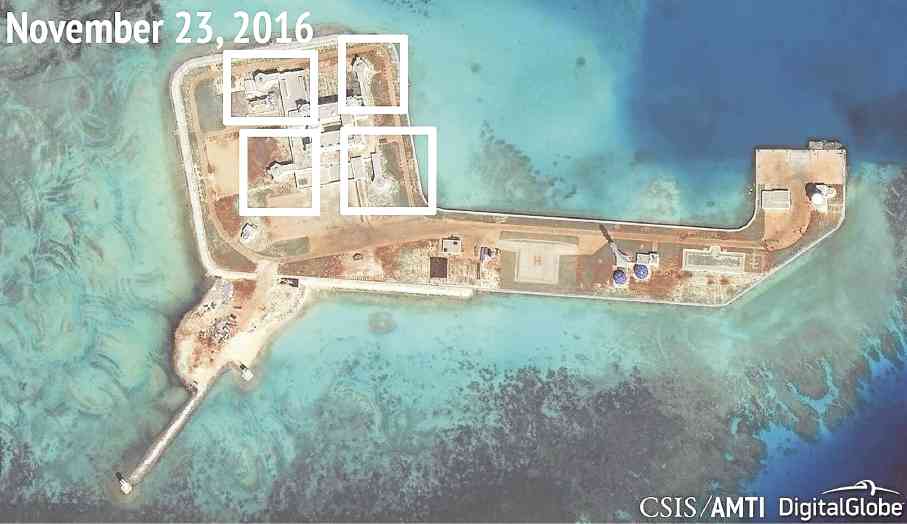Asean worried over South China Sea militarization

BATTLE-READY A satellite image released on Dec. 13 shows what CSIS Asia Maritime Transparency Initiative says appears to be antiaircraft guns and what are likely to be close-in weapons systems on Hughes (McKennan) Reef in the West Philippine Sea, part of the South China Sea. China has said it has no intention to militarize Hughes and six other artificial islands in the strategic waterway, where several countries have conflicting territorial claims.
BORACAY ISLAND—Foreign Ministers of the Association of Southeast Asian Nations (Asean) have expressed grave concern over the continued militarization in the disputed South China Sea.
“A number of ministers expressed concern over recent developments and escalation of activities in the area, which may further raise tensions and erode trust and confidence in the region,” said Foreign Affairs Secretary Perfecto Yasay Jr., during a briefing here on Tuesday. Yasay chairs the Foreign Ministers Retreat at the Shangri-La Boracay Resort.
The United States on Saturday deployed the carrier group USS Carl Vinson in the waters of the South China Sea, saying it was part of “routine operations.”
China earlier warned the US not to challenge its sovereignty in the disputed territory.
Asean member states including the Philippines and Vietnam who are claiming territorial rights in the area have repeatedly protested China’s reclamation activities in the area and the building of facilities including for military use.
Article continues after this advertisementYasay said the Asean member countries see the need to “sustain the momentum of dialogue in order to ease tensions in the region.”
Article continues after this advertisementHe said the foreign ministers “reaffirmed the importance of the need to enhance mutual trust and confidence, exercising self-restraint in the conduct of activities and avoiding actions that may further complicate the situation…”
In the meeting, the Asean member countries also “underscored the importance of the full and effective implementation of the Declaration of Conduct (DOC) on the South China Sea in its entirety,” according to Yasay.
He said the officials also highlighted the importance of efforts of the Asean and China to complete the framework of the Code of Conduct (COC) on the South China Sea by June this year in order for the adoption of the COC.
The non-binding DOC was signed on Nov. 4, 2002 in Phnom Penh, Cambodia, by Asean-member states and China as a measure to help prevent and settle territorial disputes involving the South China Sea.
It declares among others that countries should “refrain from inhabiting presently uninhabited islands, reefs, shoals, cays, and other features, and handle their differences in a constructive manner.”
The Asean Foreign Ministers believe that in order for the COC to be “meaningful and effective,” it should be legally binding and cover the broadest areas on how disputes will be resolved by parties claiming rights over the territory, according to Yasay.
He said the a non-binding and non-enforceable COC would “just simply be a piece of paper that will further prolong discussions on the matter without getting tangible results.”
He said one of the objectives of the COC would be to demilitarize the area.
Several Foreign Ministers also said that the July 2016 landmark ruling of the Permanent Court of Arbitration (PCA) on the arbitration case between the Philippines and China over the South China Sea should be respected.
In its verdict favoring the Philippines, the PCA has ruled that China does not have historic rights to the territory and rejected China’s “nine-dash line” claim.
“Whether or not China will be able to address this concern is another situation that China will have to contend with,” Yasay said.
But he expressed confidence that a framework of COC will be completed, citing China’s participation in the process.
Yasay said bilateral talks between the Philippines and China on the South China Sea would continue even with the framing of a COC. SFM
For comprehensive coverage, in-depth analysis, visit our special page for West Philippine Sea updates. Stay informed with articles, videos, and expert opinions.